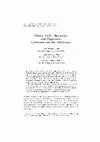Papers by John O'Leary

Psychoanalytic Psychology, 1989
This study examines the relationships between shame, guilt, narcissism, and depression and the ge... more This study examines the relationships between shame, guilt, narcissism, and depression and the gender differences connected with these states. We hypothesize that shame would be a more powerful contributor to narcissism and depression than guilt and that women would score higher in shame, higher in depression, and lower in narcissism than men. The Adapted Shame/Guilt Scale, the Narcissistic Personality Inventory, and the Self-Rating Depression Scale were administered to male and female undergraduates. The results show that shame plays an important role in both narcissism and depression, and that its role in depression is stronger than that of guilt. It was also concluded that men are more prone to narcissism and women to depression, and sex differences related to shame and guilt are linked to specific situations and self-images. Implications for treatment are also noted. Recently, there has been a resurgence of clinical and theoretical interest in the superego. One reason is the expansion of psychoanalytic interest into new territories where superego deficits are paramount (i.e., the preoedipal conditions). Kernberg (1984), for example, stated that the two most important considerations in the treatability of borderline and narcissistic states is the quality of the patients' object relations and the relative integration of their superegos.

Psychoanalytic Psychology, 1986
This article demonstrates the importance of a close monitoring of the emotion of shame in psychoa... more This article demonstrates the importance of a close monitoring of the emotion of shame in psychoanalysis. Shame is distinguished from guilt, and its special relationship to pathological narcissism is discussed. A typology of narcissistic pathology is also described, which is mediated by the extent to which grandiosity is consciously experienced by the patient. Specifically, where grandiosity is conscious and central, there is a distinct shame avoidance quality. Males tend to be overrepresented in this category. Where grandiosity is disavowed, although unconsciously present, there is a heightened sensitivity to shame. Women seem to cluster here. Case illustrations of each type are included, and theoretical approaches by Lewis, Kernberg, Kohut, and others are discussed. Shame is an emotion that has been receiving greater attention from psychoanalytic writers in recent years (e.g.
Contemporary Psychoanalysis, 1988
... Jimmy B. became derailed by this turn of events and deferred to the greater emergency in the ... more ... Jimmy B. became derailed by this turn of events and deferred to the greater emergency in the kitchen and promptly exitedleaving ... Broverman, IK, Broverman, DM, Clarkson, FE, Rosenkrantz, PS, & Vogel, SR 1970 Sex role stereotypes and clinical judgments of mental health ...
International Journal of Group Psychotherapy, 2001
The postmodern critique, often referred to as social constructionism, has influenced nearly all d... more The postmodern critique, often referred to as social constructionism, has influenced nearly all disciplines, including recently the domain of psychology-and most particularly psychoanalysis. This article presents an exposition of the "postmodern turn," including some historical perspective, a description of its theoretical elements as related to psychological practice, as well as standard objections to its theories. This author believes that many of the concepts inherent to a social constructionist approach are compelling for theory and practice in group therapy. Clinical case studies are cited in describing how postmodern theories present a natural fit for group therapy. Furthermore, specific implications of this model are delineated for the arduous task of leading groups.
Contemporary Psychoanalysis, 2008
Abstract The “two-pillar” approach to clinical treatment for depression, that is, medication and ... more Abstract The “two-pillar” approach to clinical treatment for depression, that is, medication and dynamic psychotherapy, has proven to be of limited success. I articulate a multimodal approach to treatment based on three lines of evidence: 1) my own experience with depression, 2) my experience as a group therapist for severely depressed persons, and 3) an analytic case of a depressed and suicidal woman. We need to seek remedy in disciplines other than traditional psychotherapy, including exercise, altruistic endeavors, group experience, and spirituality, all of which are worthy of more rigorous study.
Contemporary Psychoanalysis, 1996
... transference regressions (Masterson, 1981) ; (Zetzel, 1971). Finally, preparations ought to b... more ... transference regressions (Masterson, 1981) ; (Zetzel, 1971). Finally, preparations ought to be made in advance to anticipate the patient's capacity to divide the staff into rescuers and persecutors (Nurnberg & Suh, 1978). In Nancy's case, it did not benefit her to have allies on the ...
Income inequality and psychoanalytic practice by John O'Leary











Uploads
Papers by John O'Leary
Income inequality and psychoanalytic practice by John O'Leary